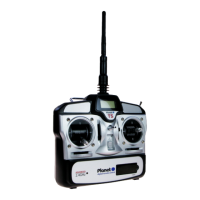Instruction Manual
1
INTRODUCTION
Thank you for purchasing an Advanced 2.4GHz Planet
T5 radio control system. It is designed for remotely
operating small or indoor R/C model aircraft safely
in the easiest possible manner without the need for
crystals.
It’s uncomplicated yet sophisticated design makes it an
ideal first system or a general purpose sport system for
R/C modelling.
It uses state-of-the-art computer technology to bind it’s
transmitter and receiver in such a fashion that, under
most model flying conditions, interference that would
normally cause loss of control in 35MHz or 27MHz
equipment is nearly always rejected—and in most
cases radio functionality is entirely unaffected. This
makes for a safer, more reassuring flying experience.
It also enables a pilot to turn up, switch on and
fly under most conditions—subject to local flying
guidelines and rules.
The new design single aerial micro receiver is
utra-compact and allows for rapid and convenient
installation especially when compared with some twin-
unit multi-aerial receiver designs.
NB. The Planet T5 is not a complete system; other parts
must be purchased in order to obtain full functionality
from this equipment.
Please read all instructions carefully before using your
Advanced 2.4GHz Planet T5 radio control system.
SAFETY INFORMATION
WARNING!
This equipment must be assembled carefully
into an appropriate R/C aircraft according to the
manufacturers’ recommendations.
Note that Planet T5 is not a ‘full range’ system and
must only be used with small Park Flyer/coaxial
helicopter type R/C models operated at relatively short
range (around 150 metres).
This product is a sophisticated control system for
model aircraft and is not a toy. Suitable only for
persons aged 14+
Check all radio equipment carefully before use and
range check before every flight.
Never fly near people, animals, buildings, power lines,
water or trees.
Ensure that all batteries are either fresh (if alkaline) or
charged (if rechargeable) before using this equipment.
Observe BMFA safety codes at all times when
operating radio controlled models
This equipment is designed to be installed and used
only within a radio control hobby environment.
2.4GHz signals are less tolerant of obstacles so never
fly close to structures, trees, hedges which if flown
behind may cause a temporary loss of signal.
Never fly in rain.
UK AIR LAW, BMFA &
SAFETY
All model aircraft operated in the UK are subject
to UK Air Law. It should be noted that in the UK a
considerable burden of responsibility and a strict duty
of care lie with the pilot of any model aircraft. Under
UK Air Law the pilot assumes all responsibility for his
aircraft.
Radio control model aircraft are potentially capable
of inflicting severe personal injury or even death to
people or animals and can cause considerable damage
to property if operated incorrectly or irresponsibly.
In the UK, the British Model Flying Association (BMFA)
(http://www.bmfa.org) is responsible for overseeing all
aspects of model flying.
If you are new to R/C modelling we strongly
recommend you download the BMFA handbook (http://
www.bmfa.org/handbook/index.html) which contains
much useful information about model flying including
legal, insurance, safety obligations and technical
recommendations for model pilots.
NEW TO RADIO CONTROL?
If you are new to radio control (R/C) modelling, please
do not expect to be able to install this equipment into a
model aircraft and immediately 'fly around'. R/C models
require time and training in order to be assembled and
flown successfully. We suggest you seek advice from
an experienced pilot or your supplier regarding flight
training and approved flying sites. If any information
in this manual is unclear, please contact your supplier
for help.
NOT WHAT YOU
EXPECTED?
If the information presented in the preceding
paragraphs and opposite is not what you expected
and you either cannot or choose not to accept
the responsibilities associated with operating this
equipment in a model in the UK, you should not buy this
product.
In the event you have already purchased this product;
you should return the product in it’s original condition
and obtain a refund from your supplier.

